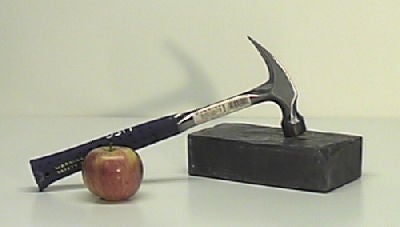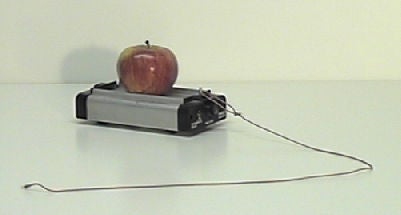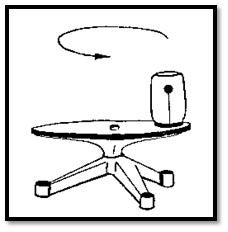-
The tablecloth can be removed from a set table without disturbing the original plate setting. Push the tablecloth downwards with one strong jerk. It works better with heavy objects on top of the table.

-
This apparatus is an easy and convincing way to demonstrate inertia. It consists of a pedestal with a concave top and an attached leaf spring, a steel ball and a square card. The pedestal is about 10 cm tall. Place the inertia apparatus on a flat level surface. Center the square card on top of the pedestal with one edge aligned parallel and close to the leaf spring. Place the metal ball on the card directly over the recess in the pedestal. If the ball rolls off the card, form a very slight impression in the card by pressing gently on the ball. Press only hard enough to keep the ball in place. Pull the spring back gently and release. The blow from the spring propels the card outward, while the relatively heavy ball has too much inertia and drops into the recess on top of the pedestal.


-
A piece of chalk is at rest on a very flexible hoop that has been balanced on top of a narrow neck bottle. When one tries to remove the hoop with a quick pull in the horizontal direction, the flexible hoop will change its shape to an oval one. As a result of the very low friction between the chalk and the hoop, the piece of chalk will fall straight into the bottle.

-
A forceful blow of hammer does not result in any injury to your hand beneath the lead brick. Place your hand flat on a table and the very heavy lead brick on top of it, carefully. With the other hand hammer the brick — you will not feel the blow! The lead brick absorbs all the impact.

-
The inertia of the cart is demonstrated by pulling the string. A quick jerk breaks the string, while a slow steady force pulls the cart.

-
A volunteer lies on a bed of nails. Another board equally full of nails is laid over him or her (pointed sides facing the volunteer’s chest). A block of concrete is piled on top. Another person then smashes the blocks with a sledge hammer. The volunteer will not be hurt! When the block is smashed and many pieces fly apart, they absorb much of the energy of the blow, the inertia of the block partially protects the volunteer from the impact, and also, the volunteer’s weight is spread over many closely set nails, reducing the force from each nail.

Click here to see a video clip of this demo.
-
This wooden block has three different axes of rotation (each with its own moment of inertia). One axis has a maximum moment of inertia, one an intermediate, and one the minimum. As you rotate the block through the three different axes, you find that only the axes with the maximum and minimum moments of inertia are stable. When you rotate through the intermediate axis, the block wobbles.

-
This demonstrates that rotational inertia depends not only on the mass, but how that mass is distributed
relative to the axis of rotation. Both wands have the same mass but different rotational inertias. This is
because the red wand has two metal slugs near its center while the blue wand has two similar slugs at its ends.
-
A jar has a Styrofoam ball attached to its lid by a short cord. The ball becomes a buoyant pendulum when the jar is filled with glycerin and inverted. Hold the jar in front of you and walk quickly across the lecture room. At first the ball will move forward in the direction of acceleration, and then returns to the vertical position when your velocity becomes constant. When you slow down, the ball will move back towards you, showing deceleration. Now set the jar on the turntable and spin it. The ball moves towards the center, showing the radially inward uniform circular acceleration.


Newton’s First law
Contact our lab
Visit Us
USC Physics Lecture Support Lab SLH (Stauffer Lecture Hall) – 104
Department of Physics and Astronomy
University of Southern California
Los Angeles
Questions or Comments
If you have questions or comments e-mail us or call at phone number below.